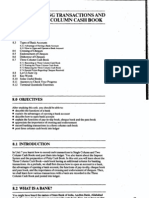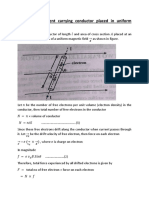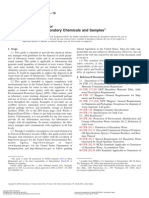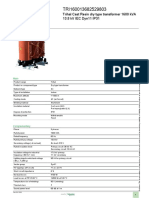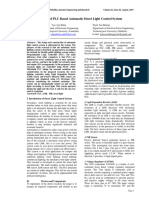Current: Series Circuits Parallel Circuits
Current: Series Circuits Parallel Circuits
Uploaded by
djjdsjCopyright:
Available Formats
Current: Series Circuits Parallel Circuits
Current: Series Circuits Parallel Circuits
Uploaded by
djjdsjOriginal Description:
Original Title
Copyright
Available Formats
Share this document
Did you find this document useful?
Is this content inappropriate?
Copyright:
Available Formats
Current: Series Circuits Parallel Circuits
Current: Series Circuits Parallel Circuits
Uploaded by
djjdsjCopyright:
Available Formats
Series Circuits
The current is the same in every
resistor; this current is equal to that
in the battery.
The sum of the voltage drops
across the individual resistors is
equal to the voltage rating of the
battery.
The overall resistance of the
collection of resistors is equal to the
sum of the individual resistance
values,
Rtot = R1 + R2 + R3 + ...
Parallel Circuits
The voltage drop is the same
across each parallel branch.
The sum of the current in each
individual branch is equal to the
current outside the branches.
The equivalent or overall
resistance of the collection of
resistors is given by the equation
1/Req = 1/R1 + 1/R2 + 1/R3 ...
As mentioned in a previous section of Lesson 4, two or more electrical devices in a
circuit can be connected by series connections or by parallel connections. When all
the devices are connected using parallel connections, the circuit is referred to as
a parallel circuit. In a parallel circuit, each device is placed in its own
separate branch. The presence of branch lines means that there are multiple
pathways by which charge can traverse the external circuit. Each charge passing
through the loop of the external circuit will pass through a single resistor present in
a single branch. When arriving at the branching location or node, a charge makes a
choice as to which branch to travel through on its journey back to the low potential
terminal.
Current
The rate at which charge flows through a circuit is
known as the current. Charge does NOT pile up and
begin to accumulate at any given location such that the current at one
location is more than at other locations. Charge does NOT become used up
by resistors in such a manner that there is less current at one location
compared to another. In a parallel circuit, charge divides up into separate
branches such that there can be more current in one branch than there is in
another. Nonetheless, when taken as a whole, the total amount of current in
all the branches when added together is the same as the amount of current
at locations outside the branches. The rule that current is everywhere the
same still works, only with a twist. The current outside the branches is the
same as the sum of the current in the individual branches. It is still the same
amount of current, only split up into more than one pathway.
In equation form, this principle can be written as
Itotal = I1 + I2 + I3 + ...
where Itotal is the total amount of current outside the branches (and in the
battery) and I1, I2, and I3represent the current in the individual branches of the
circuit.
The rate at which charge flows into anode is equal to the sum of the flow
rates in the individual branches beyond the node. This is illustrated in the
examples shown below. In the examples a new circuit symbol is introduced the letter A enclosed within a circle. This is the symbol for an ammeter - a
device used to measure the current at a specific point. An ammeter is
capable of measuring the current while offering negligible resistance to the
flow of charge.
Diagram A displays two resistors in parallel with nodes at point A and point
B. Charge flows into point A at a rate of 6 amps and divides into two
pathways - one through resistor 1 and the other through resistor 2. The
current in the branch with resistor 1 is 2 amps and the current in the branch
with resistor 2 is 4 amps. After these two branches meet again at point B to
form a single line, the current again becomes 6 amps. Thus we see the
principle that the current outside the branches is equal to the sum of the
current in the individual branches holds true.
Itotal = I1 + I2
6 amps = 2 amps + 4 amps
The actual amount of current always varies inversely with the amount of
overall resistance. There is a clear relationship between the resistance of the
individual resistors and the overall resistance of the collection of resistors. To
explore this relationship, let's begin with the simplest case of two resistors
placed in parallel branches, each having the same resistance value of 4 .
Since the circuit offers two equalpathways for charge flow, only one-half the
charge will choose to pass through a given branch. While each individual
branch offers 4 of resistance to any charge that flows through it, only onehalf of all the charge flowing through the circuit will encounter the 4
resistance of that individual branch. Thus, as far as the battery that is
pumping the charge is concerned, the presence of two 4- resistors in
parallel would be equivalent to having one 2- resistor in the circuit. In the
same manner, the presence of two 6- resistors in parallel would be
equivalent to having one 3- resistor in the circuit. And the presence of two
12- resistors in parallel would be equivalent to having one 6- resistor in
the circuit.
Now let's consider another simple case of having three resistors in parallel,
each having the same resistance of 6 . With three equal pathways for
charge to flow through the external circuit, only one-third the charge will
choose to pass through a given branch. Each individual branch offers 6 of
resistance to the charge that passes through it. However, the fact that only
one-third of the charge passes through a particular branch means that the
overall resistance of the circuit is 2 . As far as the battery that is pumping
the charge is concerned, the presence of three 6- resistors in parallel would
be equivalent to having one 2- resistor in the circuit. In the same manner,
the presence of three 9- resistors in parallel would be equivalent to having
one 3- resistor in the circuit. And the presence of three 12- resistors in
parallel would be equivalent to having one 4- resistor in the circuit.
This is the concept of equivalent resistance. The equivalent resistance of a
circuit is the amount of resistance that a single resistor would need in order
to equal the overall effect of the collection of resistors that are present in the
circuit. For parallel circuits, the mathematical formula for computing the
equivalent resistance (Req) is
1 / Req = 1 / R1 + 1 / R2 + 1 / R3 + ...
where R1, R2, and R3 are the resistance values of the individual resistors that
are connected in parallel.
Resistors
A resistor limits the electrical current that flows through a circuit. Resistance is the restriction of
current.[1] In a resistor the energy of the electrons that pass through the resistor are changed to heat
and/or light.
Calculating resistance
Series Circuit: Rt=R1+R2+R3+R4...Rn
Parallel Circuit: 1/Rt=1/R1+1/R2+1/R3...1/Rn
Where R is the resistor's value [4]
Ohms Law
The formula for Ohms law, V=I*R, states that the voltage drop across a component is equal to the
product of the current flowing in the component multiplied by the resistance of the component. When
using Ohms law, you are able to switch the formula around if needed to find a different outcome:
I=V/R or R=V/I [5]
You might also like
- NDT20 Course NotesDocument278 pagesNDT20 Course Noteshazzleraflet100% (11)
- Chem 11042 PDFDocument6 pagesChem 11042 PDFVictor Hugo Calvanapón SalasNo ratings yet
- Combination CircuitsDocument15 pagesCombination CircuitstjmNo ratings yet
- QQQ - Vectors: AB A AD B DQ DC AZDocument2 pagesQQQ - Vectors: AB A AD B DQ DC AZKenan100% (1)
- TH He Total 7 Chemactive ComDocument10 pagesTH He Total 7 Chemactive ComNavNo ratings yet
- Wave Properties - June 03Document2 pagesWave Properties - June 03Naveed AhmedNo ratings yet
- 3 - AlkanesDocument34 pages3 - AlkanesSean Gabriel LacambraNo ratings yet
- Hooke Law BasicDocument27 pagesHooke Law BasicSinaga PhilipNo ratings yet
- Analysis Series-Parallel Resistors and RLC Circuits AnalysisDocument5 pagesAnalysis Series-Parallel Resistors and RLC Circuits AnalysisDIMIL STBGNo ratings yet
- Mass, Weight and DensityDocument19 pagesMass, Weight and DensityKiron SheiqNo ratings yet
- Introduction To Vectors (Excellent!)Document17 pagesIntroduction To Vectors (Excellent!)KenanNo ratings yet
- Nuclear DecayDocument68 pagesNuclear DecayVaggelis KøtrønisNo ratings yet
- Grade 10 A Physics Assignment - MagnetismDocument8 pagesGrade 10 A Physics Assignment - MagnetismRoselyn TrixieNo ratings yet
- IGCSE Chemistry ElectrolysisDocument5 pagesIGCSE Chemistry ElectrolysisdanielmahsaNo ratings yet
- Newton's Second LawDocument56 pagesNewton's Second LawDeen ZakariaNo ratings yet
- Worksheet 2 Circle TheoremDocument19 pagesWorksheet 2 Circle TheoremAmjad AshaNo ratings yet
- Asphyxia in Forensic AspectDocument31 pagesAsphyxia in Forensic AspectSita SilastutiNo ratings yet
- As 21c Motion&ForceDocument40 pagesAs 21c Motion&ForceHany ElGezawyNo ratings yet
- 46.2-Electromagnetic Effects-Cie Igcse Physics Ext-Theory-QpDocument13 pages46.2-Electromagnetic Effects-Cie Igcse Physics Ext-Theory-QpNurul FadhilahNo ratings yet
- C11 Polymers Homework Qs MS: 105 MinutesDocument14 pagesC11 Polymers Homework Qs MS: 105 Minutesadkhan290508No ratings yet
- Lab Report No: Physics Ac-Dc ElectronicsDocument17 pagesLab Report No: Physics Ac-Dc ElectronicsSalmanNo ratings yet
- Virtual Image.: 1 (A) Fig. 8.1 Is A Ray Diagram of A Convex Lens Being Used As A Magnifying Glass To Produce ADocument11 pagesVirtual Image.: 1 (A) Fig. 8.1 Is A Ray Diagram of A Convex Lens Being Used As A Magnifying Glass To Produce AahmedNo ratings yet
- Caie A2 Level Chemistry 9701 Theory v1Document33 pagesCaie A2 Level Chemistry 9701 Theory v1Stefan BiehlerNo ratings yet
- 1.2 Motion NotesDocument8 pages1.2 Motion Notestalal150809No ratings yet
- Acids and Bases NotesDocument10 pagesAcids and Bases NotesThaarvena RetinaNo ratings yet
- Physics Paper 1, 3 Trial SPM 2013 MRSM UDocument58 pagesPhysics Paper 1, 3 Trial SPM 2013 MRSM UWaylon WebbNo ratings yet
- Extraction of Metals6Document36 pagesExtraction of Metals6manish932No ratings yet
- Chemical Nomenclature: (Naming Compounds)Document38 pagesChemical Nomenclature: (Naming Compounds)AhadSamiNo ratings yet
- Oxidation ReductionDocument7 pagesOxidation ReductionZul Abror Bin Ya'akopNo ratings yet
- Radioactivity AnswersDocument13 pagesRadioactivity AnswersPavit SuphawirojlertNo ratings yet
- IGCSE Chemistry Chemistry of ManufacturingDocument2 pagesIGCSE Chemistry Chemistry of ManufacturingdanielmahsaNo ratings yet
- Cash BookDocument15 pagesCash Bookswatee89No ratings yet
- MagnetDocument20 pagesMagnetHakim AbbasNo ratings yet
- 3d Shapes WorksheetDocument13 pages3d Shapes WorksheetAmjad AshaNo ratings yet
- Electrolysis of Aqueous Solution: RevisionDocument7 pagesElectrolysis of Aqueous Solution: RevisionAzie Nurul AkhtarNo ratings yet
- Physics Y10 Term 2 Exam Paper1Document14 pagesPhysics Y10 Term 2 Exam Paper1Ezra Loganathan MuniandiNo ratings yet
- S3 Coordinate GeometryDocument5 pagesS3 Coordinate GeometryhoihoihoihahahaNo ratings yet
- Igcse 21 MainselectricityDocument53 pagesIgcse 21 MainselectricityHany ElGezawy100% (2)
- Lab Report NewDocument13 pagesLab Report NewAszman SamianNo ratings yet
- Maths DictionaryDocument25 pagesMaths DictionaryManoj KumarNo ratings yet
- The Turning Effect of Forces: Edexcel Igcse Physics 1-5 Edexcel IGCSE Physics Pages 42 To 48Document23 pagesThe Turning Effect of Forces: Edexcel Igcse Physics 1-5 Edexcel IGCSE Physics Pages 42 To 48summer haNo ratings yet
- Force On A Current Carrying Conductor Placed in Uniform Magnetic FieldDocument3 pagesForce On A Current Carrying Conductor Placed in Uniform Magnetic FieldSamarpan KoiralaNo ratings yet
- Empirical and Molecular Formulas WorksheetsDocument1 pageEmpirical and Molecular Formulas WorksheetsNaeem MuhammadNo ratings yet
- Kasap SM Ch01 - Solution Manual For Chapter 1 Kasap SM Ch01 - Solution Manual For Chapter 1Document72 pagesKasap SM Ch01 - Solution Manual For Chapter 1 Kasap SM Ch01 - Solution Manual For Chapter 1MUCKRAKERNo ratings yet
- G.G Physics NotesDocument15 pagesG.G Physics NotesManasvi MehtaNo ratings yet
- FT 12 Gr10 P2 Qs (Electricity)Document25 pagesFT 12 Gr10 P2 Qs (Electricity)lelon810% (1)
- Lung Contusion & Traumatic AsphyxiaDocument17 pagesLung Contusion & Traumatic AsphyxiaLady KeshiaNo ratings yet
- Astm d4447Document8 pagesAstm d4447Isabel MasiniNo ratings yet
- Module 1 Lec 2 - THERMODYNAMICS 2nd QTR SY1112 PDFDocument8 pagesModule 1 Lec 2 - THERMODYNAMICS 2nd QTR SY1112 PDFJason JohnsonNo ratings yet
- Basic Concet of ThermodynamicsDocument18 pagesBasic Concet of ThermodynamicsSachin ChaturvediNo ratings yet
- Chapter 2, Linear Motion (Sec. 1)Document23 pagesChapter 2, Linear Motion (Sec. 1)FullyFaltooNo ratings yet
- Rates of ReactionDocument64 pagesRates of Reactionhingleena100% (1)
- Test For UnsaturationDocument3 pagesTest For UnsaturationJanaye IfillNo ratings yet
- Chapter 13 - Stereo IsomerismDocument18 pagesChapter 13 - Stereo IsomerismBhanu Pratap ChauhanNo ratings yet
- Stereoisomerism - Geometric IsomerismDocument4 pagesStereoisomerism - Geometric IsomerismGopi KupuchittyNo ratings yet
- Chapter 3 Forces Phy094Document44 pagesChapter 3 Forces Phy094Ameera Jamal100% (1)
- Domains and HysteresisDocument20 pagesDomains and HysteresisMuhammad Salman AttariNo ratings yet
- Balanced Scorecard Risk Management and TDocument26 pagesBalanced Scorecard Risk Management and Tagusni prayogaNo ratings yet
- Methanol Poisoning OverviewDocument5 pagesMethanol Poisoning OverviewDya AndryanNo ratings yet
- Unit 6 TrigonometryDocument18 pagesUnit 6 TrigonometryRonny JazakoNo ratings yet
- Compound Circuits or Combination CircuitDocument4 pagesCompound Circuits or Combination Circuithsejmal12345No ratings yet
- Max 6675Document8 pagesMax 6675Jeremy WoodsNo ratings yet
- Handson Technology: Connector & Cable Products Catalogue 2021Document12 pagesHandson Technology: Connector & Cable Products Catalogue 2021handson28No ratings yet
- LECTURE - 5 MekatronikaDocument12 pagesLECTURE - 5 MekatronikaKai Vector GalerryNo ratings yet
- Explosion Proof Control Device SpecificationsDocument12 pagesExplosion Proof Control Device SpecificationsAnonymous IErc0FJNo ratings yet
- Hoja de Especificaciones Wm800 - Sensor de VelocidadDocument6 pagesHoja de Especificaciones Wm800 - Sensor de VelocidadGuillermo MartinezNo ratings yet
- Depressurization LED Solar Charge Controller With Constant Current SourceDocument4 pagesDepressurization LED Solar Charge Controller With Constant Current SourceRia IndahNo ratings yet
- Static Drives PDFDocument65 pagesStatic Drives PDFVenuNo ratings yet
- N6 Industrial Electronics August 2018Document9 pagesN6 Industrial Electronics August 2018jijage9595No ratings yet
- Catalogue Havells Residential Solar Grid Tie InverterDocument8 pagesCatalogue Havells Residential Solar Grid Tie InverterAnkur SheelNo ratings yet
- Three Phase Transformer Connections PDFDocument4 pagesThree Phase Transformer Connections PDFhelen tsegayNo ratings yet
- Sapthagiri College of EngineeringDocument7 pagesSapthagiri College of EngineeringSrinivasNo ratings yet
- Edexel IAS Physics Unit 2 Physics at Work Topic 4 Technology in Space Test With Mark Scheme 16 - 17Document24 pagesEdexel IAS Physics Unit 2 Physics at Work Topic 4 Technology in Space Test With Mark Scheme 16 - 17Paul BurgessNo ratings yet
- Frequency Response of Electronic Circuits: Sedra 6: 8.1-8.3 Sedra 7: 9.1-9.3Document41 pagesFrequency Response of Electronic Circuits: Sedra 6: 8.1-8.3 Sedra 7: 9.1-9.3Abdulrahman NasserNo ratings yet
- BE - NTL MaterialDocument17 pagesBE - NTL Materialsravan_451No ratings yet
- UniMasr.com 79e3983af376cc3e0a3c7adef354815eDocument60 pagesUniMasr.com 79e3983af376cc3e0a3c7adef354815eBala MNo ratings yet
- P.S.R.Rengasamy College of Engineering For Women SivakasiDocument42 pagesP.S.R.Rengasamy College of Engineering For Women SivakasiBavithraNo ratings yet
- Trihal-1600kva Technical Data SheetDocument2 pagesTrihal-1600kva Technical Data Sheetmohammed abdul QualiqueNo ratings yet
- Comparing Smart Grid Technology Standards Roadmap of The IEC, NIST and SGCCDocument4 pagesComparing Smart Grid Technology Standards Roadmap of The IEC, NIST and SGCCEduardo FrancisNo ratings yet
- 11 CapacitorsDocument4 pages11 CapacitorsScribdTranslationsNo ratings yet
- GeoM10 Datasheet v1.7Document2 pagesGeoM10 Datasheet v1.7antonioNo ratings yet
- Ficha Tecnica Bateria Ritar Ra12 33 35ah 12v EsDocument2 pagesFicha Tecnica Bateria Ritar Ra12 33 35ah 12v EsValentín Fernández RNo ratings yet
- Wiring Diagram FH, NH: GroupDocument110 pagesWiring Diagram FH, NH: GroupStefan AslamNo ratings yet
- Kyoritsu Insulation Tester 3132ADocument20 pagesKyoritsu Insulation Tester 3132AcowiepetersNo ratings yet
- 426 18ec36 PEEI Module1 NewDocument15 pages426 18ec36 PEEI Module1 NewShruthi ShilluNo ratings yet
- TUTORIAL3 Phasesystems SOLUTIONv2Document13 pagesTUTORIAL3 Phasesystems SOLUTIONv2770300aNo ratings yet
- Design of PLC Based Automatic Street Light Control SystemDocument4 pagesDesign of PLC Based Automatic Street Light Control Systemaye aye KhineNo ratings yet
- En Standard For Maintaince of Covered ConductorDocument12 pagesEn Standard For Maintaince of Covered ConductorAnkur AgrawalNo ratings yet
- Electric Actuator WiringDocument16 pagesElectric Actuator WiringmikeswordsNo ratings yet
- Eneld Distrib RMUDocument95 pagesEneld Distrib RMUytatardNo ratings yet































